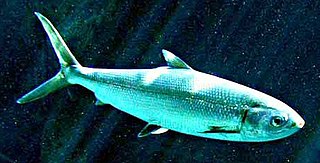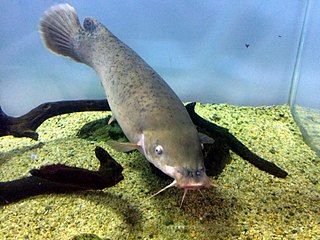
The Gonorynchiformes are an order of ray-finned fish that includes the important food source, the milkfish, and a number of lesser-known types, both marine and freshwater.
DownBeat is an American magazine devoted to "jazz, blues and beyond", the last word indicating its expansion beyond the jazz realm which it covered exclusively in previous years. The publication was established in 1934 in Chicago, Illinois. It is named after the "downbeat" in music, also called "beat one", or the first beat of a musical measure.

African tetras are a group of characiform fish exclusively found in Africa. This family contains about 18 genera and 119 species. Among the best known members are the Congo tetra, and African tigerfish.

Thoracochromis is a fish genus of haplochromine cichlids that are endemic to Africa. Most species are from rivers in Angola and Namibia, or the Congo River Basin in Central Africa, but T. wingatii is from the Nile system. Additionally, there are a few apparently undescribed species from the Nile system, which appear to be close relatives of T. wingatii or Haplochromis loati. Many species have been moved between this genus and Haplochromis, and while some consensus has been reached in recent years, their mutual delimitation is still far from settled.

Raja, also known as raia, is a genus of skates in the family Rajidae containing 16 species. Formerly a wastebasket genus, many species historically placed here have been moved to other genera in the family, such as Amblyraja, Beringraja, Dipturus, Leucoraja and Rostroraja. Raja are flat-bodied, cartilaginous fish with a rhombic shapes due to their large pectoral fins extending from or nearly from the snouts to the bases of their tails. Their sharp snouts are produced by a cranial projection of rostral cartilage. The mouth and gills are located on underside of the body. They may be either solid-coloured or patterned, and most skates have spiny or thorn-like structures on the upper surface, and some species contain weak electrical organs within their tails. Mating typically occurs in the spring and the female lays numerous eggs per clutch which are encapsulated in leathery cases, commonly known as "mermaid’s purses". Species vary in size, ranging from about 40 to 140 cm (1.3–4.6 ft) in length. These bottom-dwellers are active during both day and night, and typically feed on molluscs, crustaceans and fish. Raja skates are found in the East Atlantic, including the Mediterranean, and western Indian Ocean, ranging from relatively shallow water to a depth of 800 m (2,600 ft). Skates and related species have fossil records dating from the Upper Cretaceous period, thus this well adapted species is quite ancient.

Synodontis is the largest genus of mochokid catfishes. It is the biggest genus within the 10 genera and 190 different species in the family Mochokidae. Synodontis has over 131 different species within the genus. Synodontis are also known as squeakers, due to their ability to make stridulatory sounds through their pectoral fin spines when handled or disturbed. Synodontis make a sound that sounds like squeaking by rubbing their spines together. They do this when they have been frightened or when they become angry. Synodontis may also squeak when they are taken out of the water. These catfish are small- to medium-sized fish with many species exhibiting attractive spotted markings. Some species are also known for naturally swimming belly-up, earning the name upside-down catfish. Some of these species are Synodontis contractus and Synodontis nigriventris. While some of these species are known to swim upside down, another species, Synodontis multipunctatus, is a brood parasitic cuckoo catfish.

Albulidae is a family of fish, commonly known as the bonefishes, that are popular as game fish in Florida, select locations in the South Pacific and the Bahamas and elsewhere. The family is small, with 11 species in 3 genera. Presently, the bonefishes are in their own order: Albuliformes. The families Halosauridae and Notacanthidae were previously classified in this order, but are now, according to FishBase, given their own order Notacanthiformes. The largest bonefish caught in the Western Hemisphere is a 16-pound, 3 ounce example caught off Islamorada, Florida, on March 19, 2007.

Chiloglanis is a genus of upside-down catfishes native to Africa. These species have modified lips and barbels that form a suckermouth. They also have a naked (scaleless) body. Sexual dimorphism has been reported in Chiloglanis. The adult males of many of these species have elongate anal and caudal fins. Also, males may have an enlarged humeral process.
Kneria ruaha is a freshwater species of fish in the family Kneriidae endemic to Tanzania. It naturally lives in rivers.

Kneria is a genus of small fish in the family Kneriidae. All 13 species in this genus are restricted to Africa.

Kneria uluguru is a species of fish in the family Kneriidae endemic to Tanzania. Its natural habitat is rivers.
Parakneria tanzaniae is a species of fish in the family Kneriidae. It is endemic to Tanzania.

The Kneriidae are a small family of freshwater gonorhynchiform fishes native to Africa.

Malapterurus microstoma, the smallmouth electric catfish, is a species of electric catfish native to the Congo River basin of Central African Republic, the Democratic Republic of the Congo and the Republic of the Congo. This species grows to a length of 55.5 centimetres (21.9 in) SL. This fish can be found in the aquarium trade. It is illegal to possess any species of electric catfish for personal or commercial use in Florida.

Parakneria cameronensis is a benthopelagic species of tropical fish. The species can grow up to 8.3 cm, and are commonly found in the Congo River. The fish has a projectile upper jaw and subterminal mouth. The species' common name is Cameroon shellear.
Clypeobarbus is a genus of small cyprinid fishes native to Africa. Most species are restricted to the Congo River Basin, but C. pleuropholis is also found in the Chad Basin, while C. bellcrossi is from the Zambezi and C. hypsolepis is from rivers in Western Africa.

The Gibberichthyidae, also known as gibberfishes, are a small family of deep sea stephanoberyciform fish, containing a single genus, Gibberichthys, and two species. Found in the tropical western Atlantic, western Indian, and western and southwestern Pacific Oceans at depths of about 400-1,000 m, gibberfishes are of no economic importance. The maximum recorded size for either species is 12 centimetres (4.7 in) standard length.

Rudolf Kner was an Austrian zoologist and ichthyologist.

Enteromius is a genus of small to medium-sized cyprinid fish native to tropical Africa. Most species were placed in the genus Barbus.
The 1969 NCAA College Division football season was the 14th season of college football in the United States organized by the National Collegiate Athletic Association at the NCAA College Division level.













